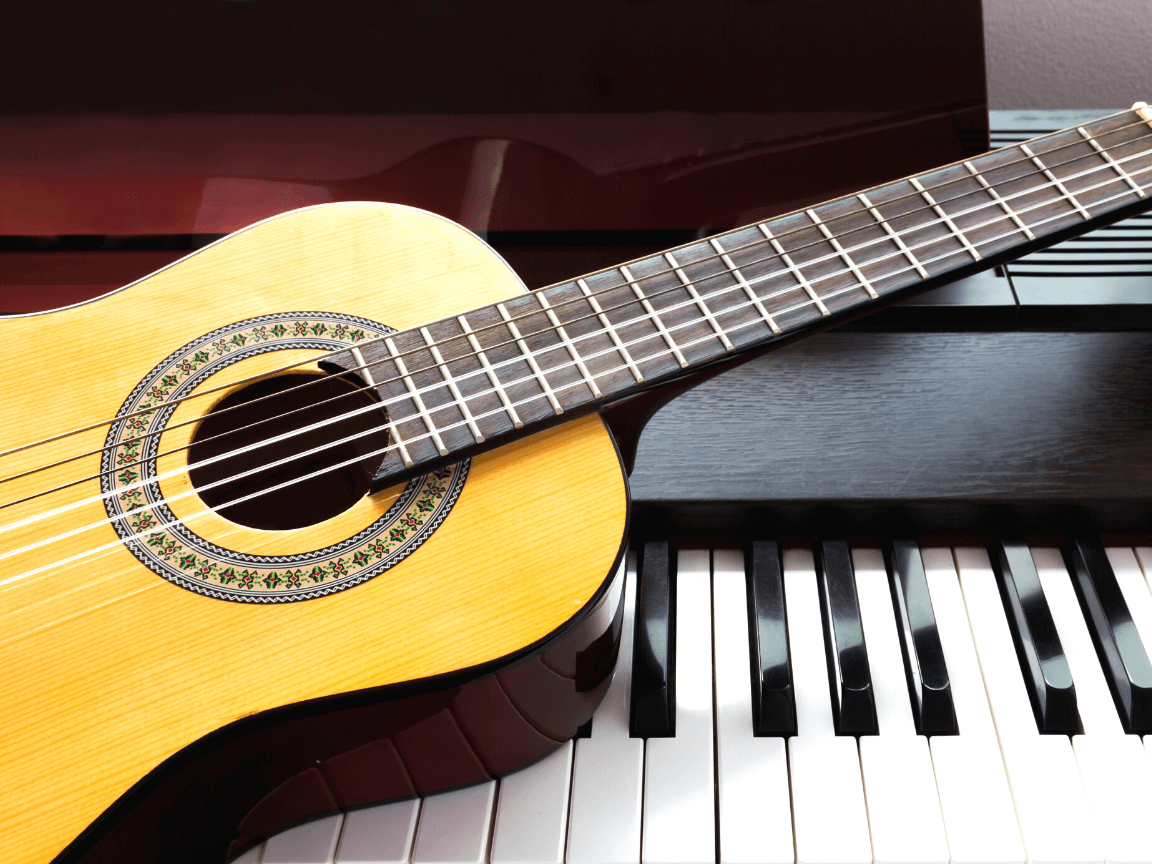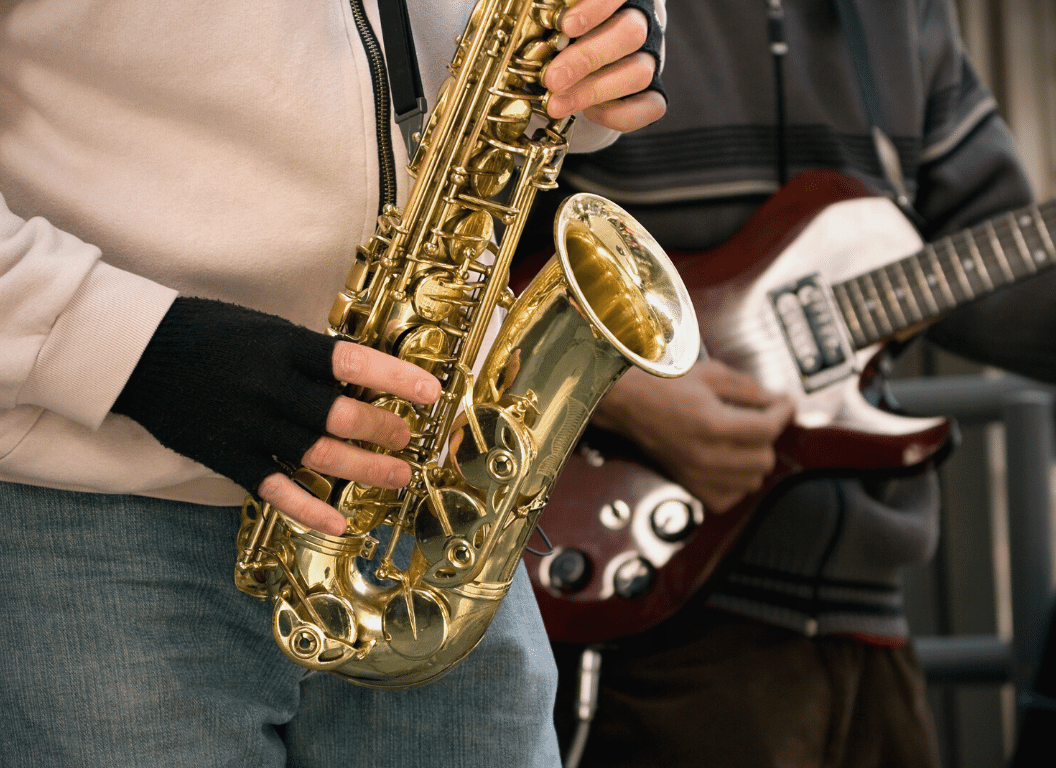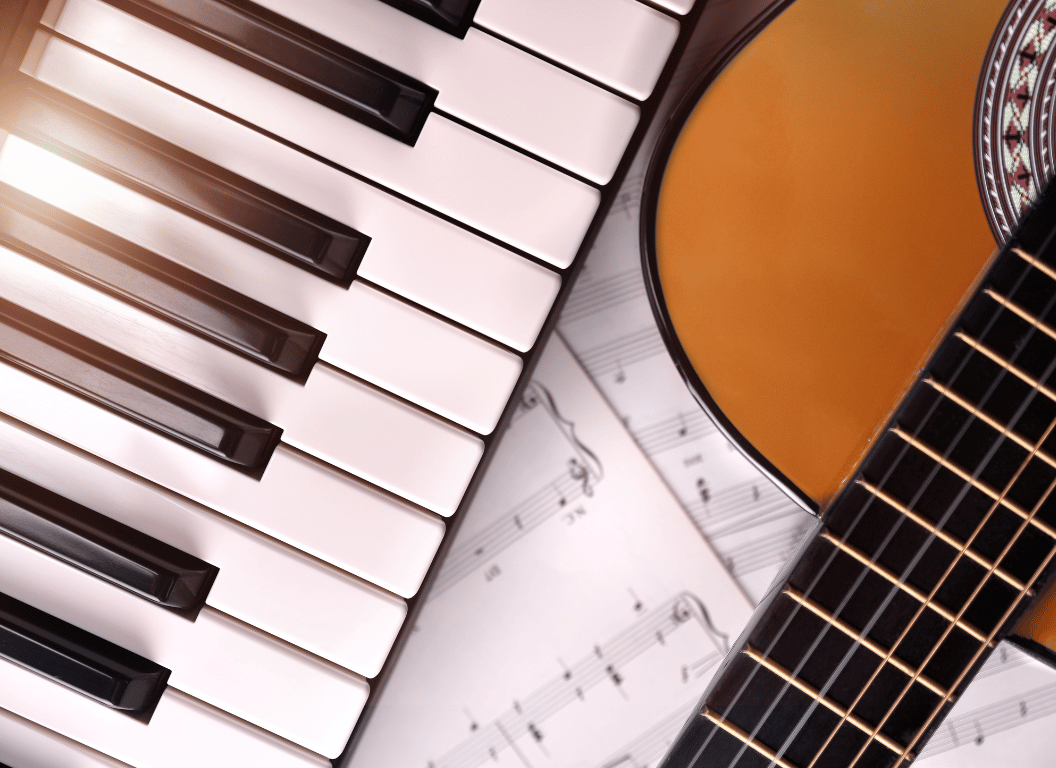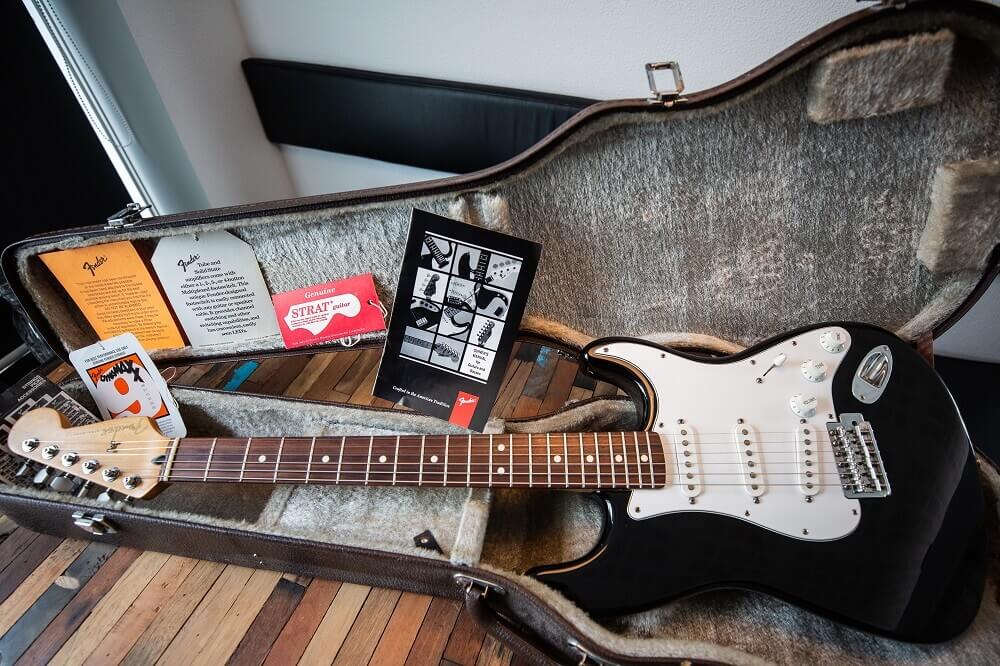Have you ever wondered if the chords you play on the guitar are the same as the chords you play on the piano?
It’s a common question among musicians, and the answer isn’t as straightforward as you might think.
In this article, we’ll explore the differences between guitar and piano chords, including how they are constructed, how they sound, and how they can be used to create different musical styles.
We’ll also look at the similarities between the two instruments and how they can be used together in a musical context.
Whether you’re a beginner or an experienced musician, this article will help you understand the differences between guitar and piano chords.
Table of Contents
- Are guitar and piano chords the same?
- History of Guitar and Piano Chords
- Similarities Between Guitar and Piano Chords
- Differences Between Guitar and Piano Chords
- How to play guitar and piano chords?
- Benefits of Learning Both Instruments
- Guitar and piano chords: Side-by-Side Comparison
- Are piano and guitar in same key?
- Is guitar harder than piano?
- How do you translate guitar chords to piano?
- Can all piano songs be played on guitar?
- Are chords the same for every instrument?
- Final thoughts
Are guitar and piano chords the same?
Yes, in theory, guitar and piano chords are the same. Both instruments use the same notes and chords, but the way the chords are played and the range of notes available on each instrument is different. On a guitar, chords are typically played using multiple strings, while on a piano, chords are usually played with multiple notes on one key. Additionally, the guitar has a much wider range of notes than the piano, allowing for more complex chords.
Also, when it comes to the sound of each instrument, even though the same chords can be played, the tone and timbre of each instrument will be different.
The guitar is much brighter and more strident than the piano, while the piano’s sound has a softer, warmer feel to it.
Of course, this depends heavily on the type of guitar and piano being used, as well as the type of strings or keys that are chosen.
Ultimately, it’s up to the musician to decide which sound they prefer.
History of Guitar and Piano Chords
1. Origin of the Guitar
The history of the guitar and piano chords is a fascinating one, as both instruments have been around for centuries and their development has been intertwined.
The guitar is believed to have originated in the Middle East in the 4th century BC, when it was known as the qitara.
Although the exact origin of the guitar is unclear, records show that it was widely used in the 9th century and popularized in Europe during the Renaissance period.
It evolved over the centuries, with the addition of strings, frets, and other features, and eventually spread to Europe in the 15th century.
The modern guitar was developed in the 19th century and has been used in a variety of musical styles ever since.
2. Origin of the Piano
The piano is also an ancient instrument, with its origins tracing back to the harpsichord in the 14th century.
It was further developed in the early 1700s, with the invention of the modern grand piano and the upright piano.
The popularity of the instrument spread throughout Europe in the 18th century, and it quickly became a popular choice for composers and musicians alike.
It quickly became popular in Europe and the United States and has been used in classical, jazz, and popular music ever since.
Both the guitar and the piano are versatile instruments, and their chords have been used in a variety of musical styles over the years.
From traditional folk music to modern rock, their distinct sounds and chords have been used to create some of the most beautiful and timeless music in the world.
The development of the guitar and piano chords has been an ongoing process, with new variations being added all the time.
Similarities Between Guitar and Piano Chords
1. Both have common chord structures
Guitar and piano chords have many similarities, the most obvious being the common chord structures and techniques used to play them.
Both instruments use the same notes and chords, so the same chord progressions can be used on either instrument.
Additionally, both instruments use similar techniques in their playing that make them both compatible when playing together.
Any progression that you see being played on a piano, will work just as well when it is played on a guitar.
2. Versatility for the musician
Guitar and piano chords are also both incredibly versatile, and they can be used to play a variety of musical genres.
Some of these genres include rock, jazz, blues, country, classical, and even modern pop music.
This versatility allows guitarists and pianists to utilize both instruments when creating their own unique sounds and arrangements.
On top of that, both instruments can be used to create a wide variety of different sounds and tones.
For example, the guitar can be played both cleanly and with distortion, while the piano can be used to provide a more delicate or grandiose sound in any mix.
3. They both have strings
Even though the guitar and piano are very different instruments, they both have strings.
Many people don’t know this, but the way the piano works is by pressing a key which causes a hammer to strike the strings inside the piano.
This occurs in the same way as a guitar, when you pluck or strum the strings, but the sound waves produced are different due to the way the piano is constructed.
Also, the strings on the piano are much thicker than those on the guitar, which allows it to have a more full and powerful sound.
Differences Between Guitar and Piano Chords
1. Different number of strings
The first difference between a guitar and piano chords is the number of strings.
As we mentioned earlier, both instruments contain strings, but the guitar has six strings while the piano typically has 88 keys.
The number of keys on a piano allows it to have much more range than the guitar, which is why pianists can play complex and intricate compositions that would be impossible to do on a guitar.
2. Different range of notes
As we said before, the range of notes on a piano is much wider than that of a guitar.
This means that pianists can play complex melodies with many different variations and nuances that would be impossible to do on a guitar.
Additionally, the 88 keys on a piano allow for more variations in texture and tone, which gives it a unique sound compared to the guitar.
In other words, the piano has a much larger musical palette than the guitar, so what may sound good on a guitar may not necessarily sound as good on the piano and vice versa.
3. They require different techniques
The final difference between the two instruments is that they require different techniques in order to play them.
Guitarists usually use their fingers or a pick to strum and pluck the strings, while pianists use their hands and fingers to press down on the keys.
As a result, guitarists must learn techniques such as vibrato and bending strings, while pianists must learn techniques such as pedaling and arpeggios.
The different techniques used to play the two instruments mean that they can be used to create unique sounds that set them apart from each other.
How to play guitar and piano chords?
1. Basic Chord Structures
Playing guitar and piano chords is an essential part of learning how to play these instruments.
To get started, it’s important to understand the basics of chord structures.
A chord is a group of notes played together to create a harmonic sound.
Chords are made up of three or more notes, and each note is played at the same time.
The notes of a chord can be played either on the same instrument or on different instruments.
Once you understand the basic structure of a chord, you can begin to form chords.
2. Forming Chords
To form a chord, you need to choose the notes that will make up the chord, and the way that we do this is by selecting from the notes of a particular scale.
For example, if you are in the key of C major, all of the notes in this scale can be used to form chords.
But which notes in particular? You may ask…
Well, the first step is to identify the root note of the chord, which will be the lowest-sounding note in the chord.
The next step is to choose other notes from the scale that are either a third or fifth interval above (or below) this root note.
These intervals create what we call triads, which are chords made up of three notes.
Once you have identified the root note and the intervals for each chord, you can begin to play these chords on either guitar or piano.
3. Playing Chords
Once you have the notes of the chord, you can begin to play the chord, you can either strum the notes if you’re playing the guitar or play them one by one on the piano.
When playing chords on either instrument, you want to make sure that each note is played evenly and at the same time, with all notes ringing out together.
Also, when playing chords it is important to press down firmly enough so that all strings (or keys) are heard.
Finally, you want to make sure that your fingering remains consistent and that you always use the same fingers for each chord.
This will help to ensure accuracy and consistency when playing chords and will make it easier to transition quickly between chords.
4. Chord Progressions
Learning how to play guitar and piano chords is not complete without understanding chord progressions.
A chord progression is a series of chords that creates an interesting musical sequence.
Chord progressions can be used in both jazz and classical music, as well as rock, pop, and other genres that use guitar and piano.
When playing a chord progression, you will want to move between chords quickly and smoothly so that the music sounds natural.
This will also help to ensure that the musical phrase or passage you are playing remains interesting and engaging for your audience.
One thing you should do is practice playing different chord progressions, as this will help build your technique and understanding of how chords work together to create music.
And later on, as you progress in your skills, you can even experiment with creating your own unique chord progressions.
Benefits of Learning Both Instruments
Do you need to choose one or could you just learn both instruments?
The truth is that learning both can actually have some great benefits.
Let’s take a look at what they could be:
1. Gaining more musical knowledge
Learning both instruments can be incredibly beneficial for any musician since not only does it increase your musical knowledge, but it can also help to improve your creativity.
By learning two different instruments, you can gain a much deeper understanding of music theory, composition, and performance.
You can learn how to play different styles of music, as well as how to use different techniques to create unique sounds.
On top of that, learning both instruments can also help you to understand the overlap between different genres of music.
For example, if you learn both guitar and piano, you can easily understand the importance of chords and how they connect different pieces of music and make them more interesting.
2. You’ll increase your creativity
Not too many people think about this, but learning two instruments can actually help to increase your creativity.
When you learn two different instruments, it opens up a whole new world of possibilities for music-making that you wouldn’t have access to if you only knew one instrument.
You can explore new sounds and techniques that would otherwise be out of reach if you were just specializing in one instrument.
You can gain a better understanding of how to combine different elements of music to create something unique that only you can make.
Also, learning two instruments can help to make you more versatile as a musician, which is great for any performer who takes on different projects.
3. You’ll be able to jam with more people
Learning two instruments can also be incredibly beneficial for those who want to jam with more people and have more fun playing music.
If you know both guitar and piano, for example, you’ll be able to join a variety of different bands or groups that require players of both instruments.
It can also make it easier to collaborate with other musicians since you’ll have more skills that they might be looking for and you can bring more to the table.
Additionally, when you know two instruments you can be a lot more open and flexible when it comes to creating music with others since you’ll have the ability to switch between different instruments to create unique combinations.
For those of you doing solo work, having two instruments can also be beneficial as you’ll have access to a wider range of sounds and textures that can help make your music stand out.
Guitar and piano chords: Side-by-Side Comparison
When it comes to comparing guitar and piano chords, there are some key differences to consider.
Guitar chords are typically composed of two or more notes played simultaneously, while piano chords are typically composed of three or more notes played simultaneously.
Guitar chords are generally simpler and easier to play than piano chords, as they require fewer notes and are often easier to finger.
On the other hand, piano chords are typically more complex and often require more skill and practice to master.
This is because piano chords often require more notes, and the player must be able to accurately coordinate their hands in order to play the chord correctly.
In other words, both your left and right hands must move together in unison.
When it comes to sound quality, both instruments can produce beautiful chords.
However, depending on the level of complexity and the type of chord being played, one instrument may be better suited than the other.
For instance, guitar chords are often used for simpler music such as pop songs or folk music because they are quick to learn and easy to play.
Piano chords, on the other hand, may be better suited for more complex pieces of music, since they require more skill and practice.
Are piano and guitar in same key?
No, piano and guitar are not in the same key.
Piano is a keyboard instrument that is tuned to a specific set of notes, usually in the key of C major.
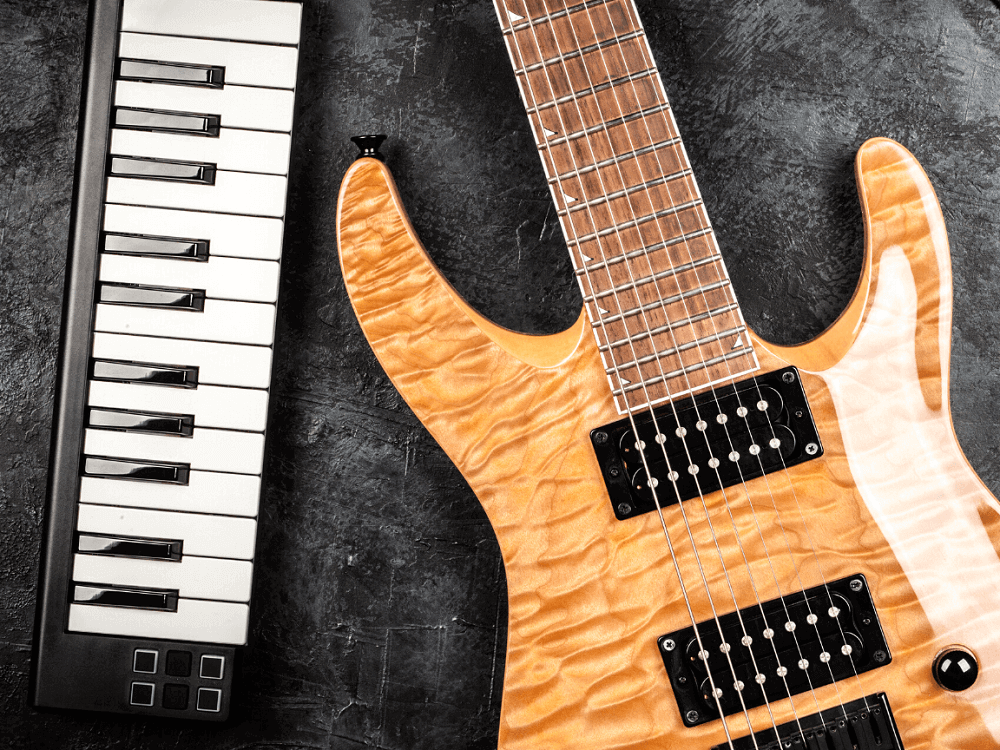
On the other hand, guitar is a fretted instrument that can be tuned to any key, depending on the player’s preference.
The notes on a guitar can be tuned to any key by adjusting the tension of the strings and essentially tuning it to what they call drops.
For example, Drop D tuning is when you lower the sixth string of a guitar down one whole step, to a D.
As a result, it is possible for a guitar to be tuned to a different key than a piano.
Is guitar harder than piano?
When it comes to deciding whether guitar or piano is harder, it really depends on the individual.
For some, guitar may be easier to learn because it is more portable and the chords are easier to remember.
On the other hand, piano may be easier for some because it is a more structured instrument and the notes are laid out in an orderly fashion.
Ultimately, it comes down to the individual’s skill level, dedication, and the amount of time they are willing to put in to learning the instrument.
Both guitar and piano require a lot of practice and dedication to master, so it’s not like one instrument is definitively “harder” than the other.
The best approach to learning either instrument is to start with one and stick with it until you reach a comfort level of playing.
How do you translate guitar chords to piano?
Translating guitar chords to piano can seem daunting at first, but with a few simple steps, you can easily learn how to do it.
The first step is to learn the guitar chord shapes and how to play them on the guitar.
Once you have mastered the basics of guitar chords, you can start to apply the same shapes to the piano.
This is done by mapping out the notes of the guitar chords on the piano and being able to locate each note of the chord.
When doing this, you need to pay attention to the root note of the chord and the intervals between the notes.
Once you have mapped out the notes of the guitar chord on the piano, you can then start to play the chord in the same way that you would on the guitar.
It is important to remember that the guitar and piano use different tuning systems, so it is important to adjust the notes accordingly.
My advise would be that instead of trying to translate entire chords, stick to the traids, and then add more notes as you go.
Can all piano songs be played on guitar?
Yes and no, in theory, any song can be played in both instruments, but they won’t sound exactly the same, or will miss certain notes.
While some songs may be able to be adapted to the guitar, others may not be possible to play due to the difference in range and the number of strings.

Piano songs often require a much wider range than what a guitar can offer so that makes it a bit harder.
Additionally, the guitar only has 6 strings, whereas a piano has 88 keys, so some of the more complex piano songs may not be able to be replicated on the guitar 100%.
It is possible to play some piano songs on the guitar, but it may require some creative adaptation and a lot of practice from the player.
Are chords the same for every instrument?
No, chords are not the same for every instrument.
Chords are created by playing two or more notes together at the same time, and the notes that make up a chord can vary depending on the instrument.

Some instruments are capable of playing chords that are not possible on other instruments.
For example, a guitar can play a barre chord, which requires pressing down multiple strings at the same time, while a piano cannot.
So, while chords may be the same in terms of the notes that make them up, the way they are played and the instruments used to play them can vary.
Final thoughts
In conclusion, it depends on the type of chord and the context in which it is used.
Guitar chords are typically more complex than their piano equivalents, and they are often used in different musical genres.
However, both instruments use the same basic chord structure and the same notes, so in some cases, the chords can be the same.
Ultimately, the decision to use one instrument over the other will depend on the context and the type of sound desired by the musician.

More than 10 years of experience playing and writing about guitars! When not writing, I can be found strumming away some Johnny Cash tunes. Favorite all time guitar is the Gibson Les Paul. #TeamGibson

